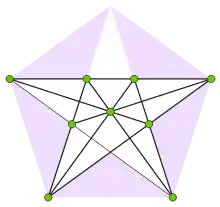Perles configuration
In geometry, the Perles configuration is a configuration of 9 points and 9 lines that can be realized in the Euclidean plane but for which every realization has at least one irrational number as one of its coordinates. It is not a projective configuration, however, because its points and lines do not all have the same number of incidences as each other. It was introduced by Micha Perles in the 1960s.[1]

It is not the first known example of an irrational configuration of points and lines. Mac Lane (1936) describes an 11-point example, obtained by applying Von Staudt's algebra of throws to construct a configuration corresponding to the square root of two.[2]
Construction from a regular pentagon
One way of constructing the Perles configuration is to start with a regular pentagon and its five diagonals, which form the sides of a smaller regular pentagon within the initial one. The nine points of the configuration consist of four out of the five vertices of each pentagon and the shared center of the two pentagons; the two missing pentagon vertices are chosen to be collinear with the center. The nine lines of the configuration consist of the five lines that are diagonals of the outer pentagon and sides of the inner pentagon, and the four lines that pass through the center and through corresponding pairs of vertices from the two pentagons.
Projective invariance
Every realization of this configuration in the real projective plane is equivalent, under a projective transformation, to a realization constructed in this way from a regular pentagon. Therefore, in every realization, there are four points having the same cross-ratio as the cross-ratio of the four collinear points in the realization derived from the regular pentagon. But, these four points have as their cross-ratio, where is the golden ratio, an irrational number. Every four collinear points with rational coordinates have a rational cross ratio, so the Perles configuration cannot be realized by rational points. Branko Grünbaum has conjectured that every configuration that can be realized by irrational but not rational numbers has at least nine points; if so, the Perles configuration would be the smallest possible irrational configuration of points and lines.[3]
Application in polyhedral combinatorics
Perles used his configuration to construct an eight-dimensional convex polytope with twelve vertices that can similarly be realized with real coordinates but not with rational coordinates. The points of the configuration, three of them doubled and with signs associated with each point, form the Gale diagram of the Perles polytope. Ernst Steinitz's proof of Steinitz's theorem can be used to show that every three-dimensional polytope can be realized with rational coordinates, but it is now known that there exist irrational polytopes in four dimensions. However, the Perles polytope has the fewest vertices of any known irrational polytope.[4]
Notes
References
- Berger, Marcel (2010), "I.4 Three configurations of the affine plane and what has happened to them: Pappus, Desargues, and Perles", Geometry revealed, Berlin, New York: Springer-Verlag, pp. 17–23, doi:10.1007/978-3-540-70997-8, ISBN 978-3-540-70996-1, MR 2724440
- Grünbaum, Branko (2003), Convex polytopes, Graduate Texts in Mathematics, 221 (Second ed.), New York: Springer-Verlag, pp. 93–95, ISBN 978-0-387-00424-2, MR 1976856
- Mac Lane, Saunders (1936), "Some interpretations of abstract linear dependence in terms of projective geometry", American Journal of Mathematics, 58 (1): 236–240, doi:10.2307/2371070, JSTOR 2371070, MR 1507146
- Ziegler, Günter M. (2008), "Nonrational configurations, polytopes, and surfaces", The Mathematical Intelligencer, 30 (3): 36–42, arXiv:0710.4453, doi:10.1007/BF02985377, MR 2437198